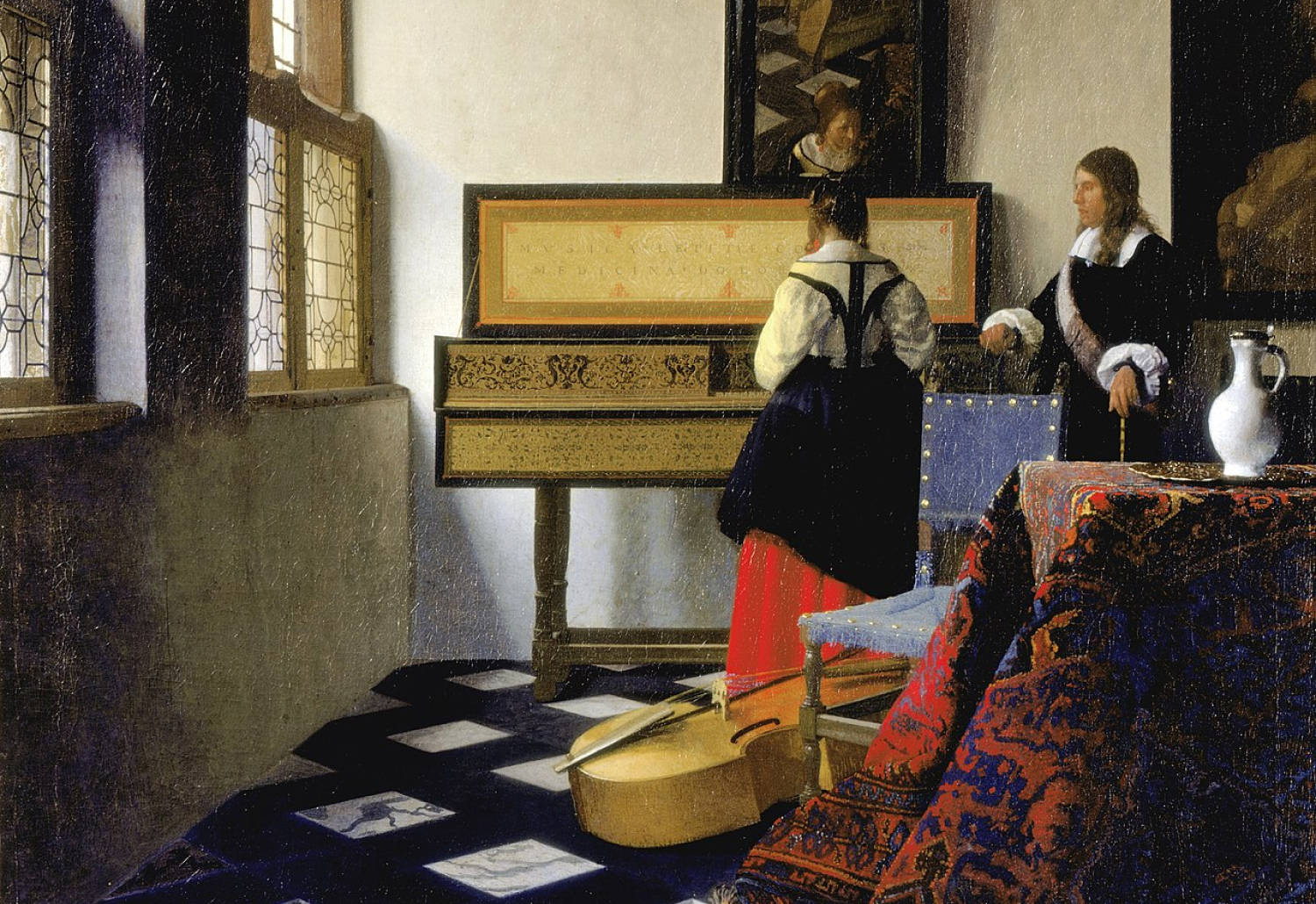The world is buzzing about Vermeer. On display at the Rijksmuseum with the most of his works gathered in one exhibition ever, there is much discussion around this celebrated Dutch painter. Yet, Johannes Vermeer is not without his secrets. We don’t know much about this enigmatic painter, having fallen into relative obscurity after death. It wasn’t until the 19th century that we would come to appreciate the Baroque-era artist, but by that point many of his records were lost and only about 36 of his paintings are known to exist today. Still, the impact of Vermeer’s famous paintings are still felt in the art world today. The world is captivated by the stillness of his illustrations, the stoicism and mystery of every day life. Here are five of Vermeer’s most famous paintings and what we know about them. If you want to learn more about Vermeer, check out our upcoming seminars with top art historians.
1. Girl with a Pearl Earring (1665)
The most recognized of Vermeer’s works, the striking use of color and light as well as its enigmatic expression of its subject makes for a stunning work of art indeed. Johannes Vermeer was nothing if not detail oriented, a fact that makes his art that much more provocative. The painter uses light to create to create a sense of depth and atmosphere. We can tell that the young woman's face is lit from the left side, which creates a strong contrast between light and shadow, bringing out the subtle details of her features, such as the texture of her skin and the reflection in her eye. Large and luminous, the impressive pearl adds another striking quality to the already bold illustrating full of contrast.
Where is The Girl with the Pearl Earring?
The painting is currently housed in the Mauritshuis museum in The Hague, Netherlands, where it is one of the museum's most popular and beloved works.

2. The Milkmaid (1658-1660)
The Milkmaid (1658-1660)
Also considered one of Vermeer’s famous paintings, The Milkmaid depicts a domestic moment in time with Vermeer’s signature striking sense of realism. The painting is notable for its use of light, which creates a sense of depth and texture in the room. Observant to the world around him, Vermeer paints a punctured hole in the window, illuminating the room with the warmth of the sunlight streaming in. The composition is also expertly balanced, with the milkmaid positioned at the center of the painting and surrounded by various objects that add to the everyday feel of the scene. It’s a beautifully ordinary scene made extraordinary
Where is The Milkmaid?
The painting is currently housed at the Rijksmuseum in Amsterdam, Netherlands, where it is one of the museum's most popular works of art.

3. View of Delft (1660-1661)
Johannes Vermeer’s works didn’t often include landscapes — there are only two surviving works in total. Vermeer’s painting of the city of Delft is one of his largest and most famous works, and is considered a masterpiece of Dutch Realism, a style of Baroque Dutch painting that depicted still, contemplative, and realistic scenes of life. True to Vermeer’s form, the famous painting incorporates incredible detail, especially in the illustration of buildings and other architectural features. And it wouldn’t be a Vermeer if the painting didn’t employ light and shadow to foster a mood of serenity. View of Delft conjures a feeling of calm and tranquility in the wee hours of the morning, right before the chaos of a day begins.
Where is the View of Delft?
This famous painting by Vermeer is also housed in the Mauritshuis museum in The Hague, Netherlands.

4. The Music Lesson (1662-1665)
Another example of Vermeer’s famous paintings, The Music Lesson shows the everyday scene of a young woman playing an instrument during a music lesson from a gentleman. Vermeer’s astute attention to detail is evident in the intricate design of the room, with its ornate decorations and furnishings. One can almost feel the cool tiled floors and the soft texture of the patterned table cloth. The beauty of this work, and other works by Vermeer, is its snapshot of everyday life. We are quiet observers lurking in on an intimate moment made more magical by its stillness. Our Dutch artist created more scenes involving music and instruments, perhaps to cut into the quiet of his scenes.
Where is The Music Lesson?
The Music Lesson lives lavishly at in the Queen’s Gallery at Buckingham Palace in London.

5. Woman with a Lute (1662-1663)
While there are countless others, Woman with a Lute is our last example of Vermeer’s famous paintings. This illustration portrays a young woman holding a lute and looking off into the distance. Woman with a Lute is another beautiful example of Vermeer's talent for capturing everyday moments with striking detail and luminosity. You’ll see that the woman’s gaze is directed away from the observer. Her contemplative expression and focused gaze suggest that we’re almost watching something we shouldn’t, an interloper on a private moment and intimate moment. Vermeer depicts these solitary moments of everyday life with precision and magic, telling us that we should care to find joy in them ourselves.
Where is Woman with a Lute?
Woman with a Lute is on display at the Metropolitan Museum of Art in New York City.

Vermeer in Context
Johannes Vermeer's legacy lives on through his famous paintings. Despite the fact that only a small number of his works have survived, Vermeer's contribution to the art world is undeniable. The use of light, color, and intricate detail in his paintings continue to captivate audiences around the world. From the enigmatic Girl with a Pearl Earring to the tranquil View of Delft, Vermeer's famous paintings represent a mastery of form and technique that has stood the test of time.













